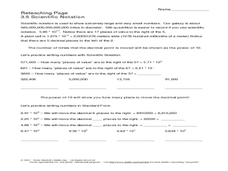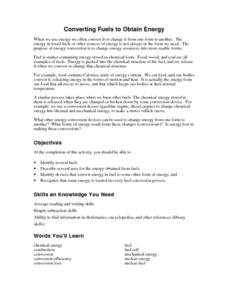Curated OER
Molecules of Life
In this molecules worksheet, students read a 1 page article on molecules and then answer 10 true or false, multiple choice, short answer and/or fill in the blank questions referring to the article.
Curated OER
Chlorophyll
Students use thin layer chromatography, TLC, to separate various pigments found in plants.
Curated OER
Taking Care of Pets
Young scholars and teacher discuss having pets such as dogs and/or cats, etc. They then read a book about pets and listen to a veterinarian visit with the them about their work and taking care of animals.
Curated OER
Chemical Energy
In this science worksheet, learners fill in the blank for 15 sentences about chemical energy. For example, "Chemical bonds hold_."
Curated OER
Walk and Talk Health and PE Activity
Learners practice concepts they are studying while exercising. In this health and fitness lesson, studnets walk and job while discussing current classroom lessons.
Curated OER
Understanding Scientific Notation
In this understanding scientific notation worksheet, 6th graders read the examples, then practice 3 writing numbers with scientific notation and 3 numbers in standard form.
Curated OER
Number Theory: Scientific Notation
In this scientific notation worksheet, students solve a total of 10 problems, writing numbers given in problems using scientific notation, then numbers given in scientific notation in standard form.
Curated OER
Scientific Notation Worksheet
In thsi scienfic notation worksheet, learners answer 10 questions converting back and forth between scientific notation and standard form. Students write very big and very small numbers using scientific notation.
Curated OER
What is Life? Demonstrations & Discussion
Display seven items for your biologists to consider. Are they living or non-living? How can you tell? This is a simple outline of what you can display and questions that can be discussed as this topic is explored. One way to use this...
Curated OER
Pollination Power
Students go out into the garden and observe pollinating animals through hand lenses. In this pollination lesson plan, students also discuss how animals carry seeds to create new plants elsewhere.
Curated OER
Functions of Leaves
The title is a little deceiving since only one of 17 slides is dedicated to the function of leaves, while the rest is dedicated to the structure. Both internal and external structure is taught with accompanying diagrams. If you are going...
Carnegie Mellon University
How Power Plants Work 1
First of three lessons, this is a great start to a unit on energy. As you demonstrate, learners discover different types of energy and how it is converted from one form to another. They then focus in on the generation of electricity by...
Carnegie Mellon University
How Power Plants Work 2
In this second of three lessons on power plants, future engineers find out how we generate electricity and how coal-powered plants operate. They work in small groups to make electromagnet generators to light LED bulbs. A set of...
Biology Junction
Seed Plants: Gymnosperms and Angiosperms
One of the reasons plants found success on land relates to seed development. Scholars learn about many different forms of seeds and how they changed over time. It describes the structure and function of many different types of seeds in...
PBS
The Egg
The first stage in the butterfly's life cycle is the egg. Young entomologists discuss why different butterflies lay different eggs and what their eggs look like. Then they use the handouts to make a replica of one type of butterfly egg...
Curated OER
Dating a Volcanic Eruption
Students discover the various ways in which tree rings can give information. After a brief disucssion of concentric tree rings, they use cross section cut outs of tree rings to identify the time and type of various naturally occuring...
Curated OER
Chapter 16, Food Biotechnology
Although the points given on these slides are valid, the visual accessibility is poor. Consequently, many viewers would be distracted or entirely unable to view the presentation. The content is a review of microorganisms and their...
Curated OER
The Beagle Brigade
Students develop an understanding of animal behaviors through reading a case study about detector beagles. They explore the interaction of innate abilities and learned behaviors.
Curated OER
Converting Fuels to Obtain Energy
Students experiment with converting fuels to energy. They also must identify different types of fuels and ways to conserve energy.
Curated OER
Ready for Roots
Fourth graders sort seeds and predict what conditions are needed for them to germinate. They keep the seeds moist, observe and measure their growth and graph the results. As the seeds start to grow students compare and contrast the each...
Curated OER
Bacteria
Students study the advantages and disadvantages of bacteria. In this bacteria lesson students draw and label the different types of bacteria.
Curated OER
English Vocabulary Skills: AWL Sublist 6 - Exercise 5b
For this online interactive English vocabulary skills worksheet, students answer 10 matching questions which require them to fill in the blanks in 10 sentences. Students may submit their answers to be scored.
Curated OER
Coral Polyp Party
Students complete a project where they label the parts of a coral polyp and discuss the differences between plants and animals. Students use marshmallows, sprinkles, toothpicks, and more to label their coral polyp.
San Francisco Public Utilities Commission
Recycled Water: A Smart Way to Reuse Water
Learn about wastewater and recycled water with a science reading activity. After learners finish a two-page passage about conserving the water supply, they answer six comprehension questions about what they have read.
Other popular searches
- Animal and Plant Cells
- Specialized Plant Cells
- Animal Cells Plant Cells
- Animals and Plant Cells
- Animal & Plant Cells
- Compare Plant Animal Cells
- Animal Plant Cells
- Plant Cells Photosynthesis
- Plant Cells Edible Projects
- Label Plant and Animal Cells
- Plant Animal Cell Diagram
- Plant Cells Organelles

























